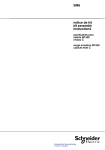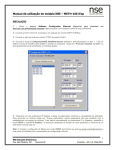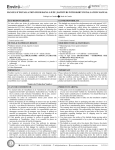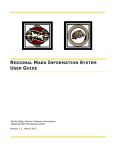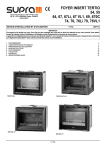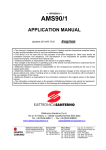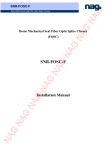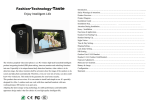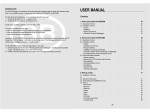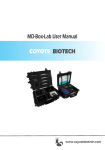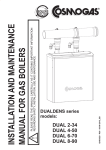Download Chapter 2 - Optel
Transcript
1 152 M Users Manual (draft) Please read carefully before operating and always keep this user manual with the equipment Users manual v1.2 7/15/2010 3:00:25 PM Document N°152M20100118 Document propriété de OPTEL THEVON SAS 2 Chapter 1 Warning OPTEL-THEVON is a registered trade mark No part of this user manual can be reproduced, copied, forwarded, saved, or uploaded without the prior written agreement by OPTEL THEVON. OPTEL-THEVON agrees for a unique copy, if and only if this integral warning is included in the copy. Data included in this manual can be modified without any prior notice. OPTEL-THEVON reserves the right to modify and improve its products. Therefore this user manual may be out of date and the company has no obligation beyond this notice to any users related entities. If necessary, please consult the latest updated version of the manual in French regarding use and operation of the 152M sensor. OPTEL-THEVON is not responsible for the accuracy of the information of the user manual, nor for its translation. Users manual v1.2 7/15/2010 3:00:25 PM Document N°152M20100118 Document propriété de OPTEL THEVON SAS 3 Chapter 1 Thanks for choosing OPTEL-THEVON sensors which are the result of a continuous cooperation with our customers, from the start of our company in the early of the seventies. Our innovative concepts are lead by the strong involvement of the OPTEL-THEVON team to understand and suit users’ daily needs and ultimate requirements in terms of measurement equipment. With the 152 series, you now have a range of very advanced laboratory instruments, easy to use, robust and unique. Please read carefully both user manual and technical data sheets before using OPTEL-THEVON sensors. Introduction We have to keep in mind that OPTO sensors are threshold’s sensors. This is important especially for the proximity detection mode, the most commonly used for rotating: working distance could change with the albedo and/or the form and distance of the target, also, contrast appears as an important parameter: teeth-no teeth, black and white marks. The recommended distance for encoding application is a few millimeters: put the probe closed to the target to avoid an incorrect reading resulting from rocking and wagging of the turning part (Descartes optical law); on the other hand, OPTEL THEVON reflective tape allows for much more than 100 mm.. It is highly recommended that you use the OPTEL THEVON adhesives encoders for optimal results. A few phenomena may affect the detection function, such as a drop of liquid on top of the probe, excessive dusts covering the top, more generally, a non transparent environment for our light source such as: diesel engine sump film ( i.e. carbon is not transparent for the near I.R.). Users manual v1.2 7/15/2010 3:00:25 PM Document N°152M20100118 Document propriété de OPTEL THEVON SAS 4 Chapter 1 Chapter 1 INTRODUCTION Chapitre 2 GENERAL OVERVIEW Chapter 3 SET UP PLUG IN Chapter 4 UTILIZATION Chapter 5 CAUTION Chapter 6 CERTIFICATS Users manual v1.2 7/15/2010 3:00:25 PM Document N°152M20100118 Document propriété de OPTEL THEVON SAS Warning Introduction Table of content Sensor package set Probe package set Sensor functional description Probe functional description How it works Sensor Drawing Power supply by USB converter Checking emission Connection probe to sensor Lights at works concept How to position probe (proximity) How to adjust the probe Probes’ accuracy How to set up probes (through beam mode) Distance indication Sensor Probe Conformity certificate 2 3 4 5 6 7 10 11 12 13 14 15 16 17 18 19 20 21 22 23 25 26 5 Chapter 2 GENERAL OVERVIEW: Sensor package set 1x Bag containing: 1 Sensor 1 Screw bag - 1 3*8mm screw - 1 hand screw - 1 washer Users manual v1.2 7/15/2010 3:00:25 PM Document N°152M20100118 Document propriété de OPTEL THEVON SAS 6 Chapter 2 GENERAL OVERVIEW: Probe package set 1Bag containing : 1 Optical fiber probe 1 Screw bag - 1 3*8mm screw - 1 hand screw - 1 washer Probes are sold separately Users manual v1.2 7/15/2010 3:00:25 PM Document N°152M20100118 Document propriété de OPTEL THEVON SAS 7 Chapter 2 Functional Description-Sensor An optical sensor is made of two parts: Firstly, the amplifier, including sensitivity setup and operating indicator, and secondly the optical fibre probe Electrical cable Opto converter: the Sensor Optical fibre probe: The Probe Probes are sold separately Users manual v1.2 7/15/2010 3:00:25 PM Document N°152M20100118 Document propriété de OPTEL THEVON SAS 8 Chapter 2 Functional Description-Sensor Electrical connection Mid-range sensivity Index position Output status LED Sensitivity adjustement + Turn clockwise a ¾ turn 1.5 m Electrical cable Optical head: connection to the Probe Users manual v1.2 7/15/2010 3:00:25 PM Document N°152M20100118 Document propriété de OPTEL THEVON SAS 9 Chapter 2 Functional Description-Sensor Reception wave in near I.R. (Photo-diode) TTL 1 0 Working Analog Amplification DC IN 12-24Vcc Gnd Emitting waves : one for working light in near I.R., one visible for control, according to the OPTEL THEVON patented concept Users manual v1.2 7/15/2010 3:00:25 PM Document N°152M20100118 Document propriété de OPTEL THEVON SAS 10 Chapter 2 Functional Description-Probe Probe connection to the sensor Optical fibre probe with coloured sheathing option (SURG G) Reading head ref: SLITYO HM6X20 Probes are sold separately Users manual v1.2 7/15/2010 3:00:25 PM Document N°152M20100118 Document propriété de OPTEL THEVON SAS 11 Chapter 2 How it works Proximity mode Our two light guides plugged to the amplifier 152 work as a separate optical head reader using a working light wave in near I.R. Both are assembled in the same ending and the light comes out from the top of the probe, which receives it back after reflection on any kind of materials or form: plastic blades, iron or aluminum teeth, small turbines. The signal is electronically treated by the sensor, which gives “all or nothing” information, dedicated for accurate application. Working distance change with the albedo from shiny surface to dull black. Product reference includes the letter “Y”. Through beam mode Same mounting with proximity mode, except for the ending with two separate channels, acting as an optofork. The way to detect tooth or phonic wheel and sometimes with V mounting, selecting detections are possible (i.e with oil).Product reference includes the letter‘FF’. Users manual v1.2 7/15/2010 3:00:25 PM Document N°152M20100118 Document propriété de OPTEL THEVON SAS 12 Chapter 3 Sensor set up Sensor Nominal Voltage Full range 152 M 12Vcc 24Vcc 10Vcc 30Vcc Power supply must be perfectly rectified, filtered, and constantly deliver more than 120 mA. This is not an “open collector” output Sensor, but PNP. The output is a gate. 152 M cannot support reverse tension, this tension could damage the sensor. If the sensor is connected to an acquisition system the use of dedicated measurement connectors and matching cables is recommended. Please refrain from extending the electrical cable. Otherwise, the sensor’s operation may be affected. Users manual v1.2 7/15/2010 3:00:25 PM Document N°152M20100118 Document propriété de OPTEL THEVON SAS 13 Chapter 3 Drawing-Sensor plug-in Gate output+Analog If the cable is trip on the 152 M, a blue wire can appear : this wire is not used. Do not connect this wire. Users manual v1.2 7/15/2010 3:00:25 PM Document N°152M20100118 Document propriété de OPTEL THEVON SAS 14 Chapter 3 Power Supply by USB Converter The sensor can be powered by OPTEL THEVON USB converter with customized connector, including two connectors: one customized and one BNC Moreover a rechargeable battery pack is also available as accessory in the OPTEL-THEVON catalog. Accessories are sold separately Users manual v1.2 7/15/2010 3:00:25 PM Document N°152M20100118 Document propriété de OPTEL THEVON SAS 15 Chapter 4 Operation: Emission Verification To confirm that the sensor is live, check if a faint red LED glows on the small light channel in front of the sensor, put the potentiometer at the max position. You can also use a digital camera to see the IR light. Note: for 152 M sensors, the brightness of this small red light depend of the position of the potentiometer Users manual v1.2 7/15/2010 3:00:25 PM Document N°152M20100118 Document propriété de OPTEL THEVON SAS 16 Chapter 4 Connection Probe to Sensor Or Users manual v1.2 7/15/2010 3:00:25 PM Document N°152M20100118 Document propriété de OPTEL THEVON SAS 17 Chapter 4 Operation of ‚Lights at Works’ Concept Operational mode of the sensor can be seen at the end of the optical fibre by a light beam (not dangerous), which is emitted when the sensor is in “1” mode and not emitted when the sensor is in “0” mode. The sensor keeps its wave length in close Infrared to ensure power and immunity of the detection function. This also gives an indication about the condition of the optical fibre. Users manual v1.2 7/15/2010 3:00:25 PM Document N°152M20100118 Document propriété de OPTEL THEVON SAS 18 Chapter 4 How to position the probe in proximity mode The 152 M is a multiple-use calibration tool, efficient over long lengths of optical fibres or for measurements on turbo engines but also suitable for encoding applications where precision in detecting markings or teeth is required: power reserves are most important here but also adaptability in settings. If you find the functioning of the combination of sensor with probe with a performance setting close to minimum, thus leaving a weak amplitude or if the sensor visibly seems too strong, it is recommended in this case in order to return to the full setting range of the potentiometer to put washers under the rivets that connect the fibre with the reading head. The thickness of such washers could be between 1.5mm to 3.0mm. Each rivet needs to be equipped with a washer in order to ensure the balance of the emission and reception channels. The patented concept implemented in the OPTEL-THEVON sensors strongly simplifies mounting and set-ups. Prior to measurement, it is recommended that a detection test be perform, even at low speed, to ensure detection feasibility and determine detection distance required for the sensor. If impossible to perform a test due to technical reason or mounting specifics, a theoretical method would be to fix the probe at a distance equivalent to the width of the black and width strips to detect- in any event, without exceeding 4mm. Important: fixing and support of the probe will influence acquisition of the reading. Please be careful regarding vibration. We recommend that you design your supports including appropriate vibration orders studies. The further the probe will be away from the target, the more the TTL amplitude signal will decrease. Users manual v1.2 7/15/2010 3:00:25 PM Document N°152M20100118 Document propriété de OPTEL THEVON SAS 19 Chapter 4 Methodology of adjustment of the probe 1 and 2/ Potentiometer in mid position. Bring the probe closer to the target until the indicator at the head lights up, targeting the white mark. 2 and 4/ Shift the probe, and repeat this operation in order to detect the triggering limits on the black marks of the target. Set up the probe in an average position (length), check one last time: the set up is finished. 1 3 2 4 Trick: if white and black marks are periodicals with identical width, after performing steps 1 and 2 in static mode, you may optimize adjustments in dynamic mode, using a digital voltmeter on the output of 152 TTL version sensors You just have to adjust the potentiometer to obtain 2,5Vcc ( 5Vcc/2). Users manual v1.2 7/15/2010 3:00:25 PM Document N°152M20100118 Document propriété de OPTEL THEVON SAS 20 Chapter 4 Operation: Probes resolution Targeting contrasted marks : i.e adhesive encoders by OPTEL-THEVON named “mires” (MR) MULTI YO : width of each top = 2mm MULTI SLIT : width of each top = 1mm Users manual v1.2 7/15/2010 3:00:25 PM Document N°152M20100118 Document propriété de OPTEL THEVON SAS 21 Chapter 4 Set up of the probe: through beam mode Place the reception channel close to the phonic wheel to make a diaphragm effect. Users manual v1.2 7/15/2010 3:00:25 PM Document N°152M20100118 Document propriété de OPTEL THEVON SAS 22 Chapter 4 Max. set-up distances* according to type of target 25X25mm 152 M grey 11 mm white 18 mm Reflective tape 210 mm *potentiometer in maximum position.- 2 meters long optical fibre probe MULTI YO. Double-check that set-up distance is appropriate to avoid any contact with the target Contact our technical support for information about optimal distance to be kept when using adhesive encoders by OPTEL-THEVON. Users manual v1.2 7/15/2010 3:00:25 PM Document N°152M20100118 Document propriété de OPTEL THEVON SAS 23 Chapter 5 Operation: Caution – warning We recommend to carefully follow technical datasheets’ instructions Use, manipulation and connections of sensors and probes are dedicated professional peoples, which are aware of security rules and procedures. OPTEL-THEVON sensors are not to be use in explosive atmospheres. Sensors may contain a low quantity of silicone sealing. Do not place the cable of the sensor on a warm surface, it could damage it Electric cable is made for a low mobility use. Prepare electrical and mechanical insulation of the sensor from the frame Users manual v1.2 7/15/2010 3:00:25 PM Document N°152M20100118 Document propriété de OPTEL THEVON SAS 24 Chapter 5 Operation: Caution – Warning OPTEL-THEVON sensors are manufactured to comply with the highest quality and roughness requirements, however as with car tires, where useful life depends on environment and driving style, sensors have a stress memory. In order to clean the active parts, please use a product dedicated for cleaning eyes glasses. θ Users manual v1.2 7/15/2010 3:00:25 PM Document N°152M20100118 Document propriété de OPTEL THEVON SAS 25 Chapter 5 Operation: Caution – Warning OPTEL-THEVON optical fiber probes can be classified in 3 operational modes Sedentary : calm environment, i.e on fixed test bench Nomad : mounting and dismounting on/from test benches frequently Endurance : under harsh environment, very difficult repeated conditions of use, i.e fatigue measurements on test benches or on board vehicles. Make sure that the distance between end of the probe and the target is sufficient for avoiding collision. Standard sensors are not prepared to be used at pressures beyond normal atmospheric pressure. Sensors are made of optic fibre bundle of glass material inside a housing, In case of damage are breaking, avoid any contact of the remains with eyes, skin or sensitive parts Sensors and optical fibers are classified as wear parts. Users manual v1.2 7/15/2010 3:00:25 PM Document N°152M20100118 Document propriété de OPTEL THEVON SAS 26 Chapter 6 Certificate of Conformity Certificate of conformity according to the directive 89/336/CEE4 Dealing with the electromagnetic compatibility test Issued to OPTEL-THEVON Standard EN 61000-6-2 of 1999 Standard EN 610006-4 of 2001 Tests, conditions and results are given in the LCIE* Test reports: N°41666010, N°424 843, N°41666020 Certificate was established by a competent notified body (89/336/EEC directive) *LCIE: Laboratoire Central des Industries Electriques Users manual v1.2 7/15/2010 3:00:25 PM Document N°152M20100118 Document propriété de OPTEL THEVON SAS



























